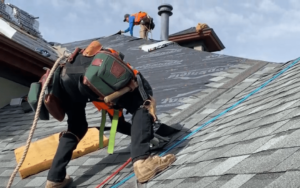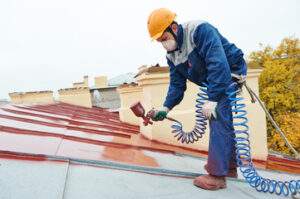Canton Roof Repair involves fixing leaking or damaged roof components. It’s generally a smaller and less expensive project than a full replacement.
It’s best to do any roofing repairs during warm and dry weather. Nobody wants to be up there in the howling wind, driving rain, or a blizzard.

Your roof and shingles take a beating from the elements. Heavy winds, severe storms, prolonged cool weather, and age can all cause shingle damage and leave your home vulnerable to leaks and other problems. If you notice a missing or cracked shingle, addressing it immediately before the situation worsens is important.
The first step is to access the area of your roof where you need to repair a broken shingle. Depending on the location of the damaged shingle, you may need to climb onto the roof to access it. A good option is a roofer ladder, which can be rented or purchased from most home improvement stores. These ladders are designed specifically for use on roofs and have stabilizing hooks that latch onto the shingles to keep the ladder in place.
Once on the roof, locate the missing shingle and loosen it above it using a shingle pry bar. Work slowly to avoid damaging the shingles around it, and be sure to remove any nails attached to the shingle. Once you’ve removed the old shingle, lay a bead of roofing sealant along the glue strip at the base of the new shingle and press it down firmly. If you want, you can also apply a sealant bead over the existing shingle’s crack to further strengthen it and provide an additional barrier against leaks.
Another common roof shingle problem is cracking, which happens over time due to normal wear and tear. While these cracks typically look shallow, they still leave your shingles vulnerable to damage from high winds. To prevent further cracking, it is important to inspect your roof regularly for early signs of damage and replace worn shingles as needed.
Cracked shingles can also develop blisters, which look similar to bruises. These blisters expose the underlayment of your roof and can lead to leaks, mold, and other problems. It is best to repair these shingles before they break and allow water to seep into your attic. If you notice this type of shingle damage, contact your residential roofing contractor right away for a roofing repair estimate.
Damaged Flashing
A roof flashing is a metal, lead, or rubber molding installed around penetrations like chimneys, toilet vents, and roof windows to direct water away from the structure. If damaged, it can leave your home vulnerable to internal leaks and water damage. It’s important to inspect your flashing regularly for signs of damage.
Common indicators include bends, cracks, or dents, which may seem minor but can compromise the galvanized coating on steel or weaken the structure of other metals. Cracks and dents are also more likely to rust, which increases the likelihood of leaks. Internal leaks near windows, fireplaces, or skylights indicate that the flashing has been compromised.
If you do find some flashing damage, there are several ways to repair it to prevent leaks. For a quick fix, flashing tape is an excellent option. Apply the tape over the impacted area to ensure it’s adhered tightly for a secure waterproof seal. This is a temporary solution, however, and you’ll still need to contact a roofing repair expert for comprehensive repairs.
For more extensive damage, you can use roofing cement or caulk to seal any visible gaps or cracks in the flashing material. Applying a high-quality, roof-specific product is important for the best results. Be sure to smooth the sealant with a putty knife for an even finish. You can also replace any damaged or missing sections of the flashing.
Regular inspections and prompt repairs are the best way to prevent flashing damage. If you suspect you have a problem, it’s vital to get it fixed quickly to avoid costly leaks and damage to your home. So, don’t delay—call a trusted local roofing contractor today!
Leaking Gutters
Gutters are meant to collect and disperse rainwater from the home to prevent water damage to siding, windows, doors, and foundations. However, when a gutter leaks, it can cause serious issues inside and outside the home. Leaking gutters often lead to drywall cracks, mold growth, musty smells, and other signs of water damage. This is why it is important to inspect your gutters regularly for clogs, holes, and other problems that can cause leaks.
Leaking gutters are usually caused by the seams of the gutter becoming loose or unsealed. This can happen due to expansion, contraction, vibration, temperature changes, and normal wear and tear. If not addressed immediately, this can cause significant damage to the home’s roof and interior. Sealing all gutter seams is important to ensure no moisture enters the house.
Another common cause of leaking gutters is rust or corrosion of the gutters. This can occur when metal gutters are exposed to salty air or soil or when they aren’t aren’t painted properly. It’s important to have your gutters professionally inspected and painted when needed to prevent this type of damage.
Gutter leaks can also occur in the corners of your gutter system. These can be caused by sagging or collapsing gutters, heavy snow and ice, or normal wear and tear. Gutter leaks are typically a sign of a bigger problem that needs to be addressed, such as replacing the gutter system.
Another common cause of gutter leaks is loose fasteners that hold the gutter to the fascia board. It’s important to ensure that the gutters are secured tightly to the fascia boards so that no water can enter the home. If you need clarification on whether the gutters are loose, use a bubble level to measure the distance between the bottom of the gutter and the edge of the fascia board. You must tighten or replace the gutters if they are above the recommended level. This can be a dangerous job, so be sure to use a sturdy ladder and ask for help from a friend or family member.
Leaking Soffit
Whether they’re-they’re made of traditional timber or modern UPVC, soffit and fascia boards play a vital role in any sloping roof. They protect the underside of the eaves and prevent pests from building nests in these areas while also providing airflow and moisture control. Over time, however, these components can deteriorate due to weather and other factors. As a result, the wood may soften or develop holes, which can lead to the penetration of rainwater into the home.
If you suspect a leaky soffit, start by checking for signs of water damage to the roof deck and framing and discolorations or marks on the ceiling below. If these are present, look for the source of the leak, and be sure to place buckets or other containers beneath the leaking area to catch the falling water. You can also test for a roof leak by going up on the roof with a hose and spraying different regions. Be sure to stay on secure framing and avoid standing in shingle areas.
In addition, check for sagging spots on the soffit and roof deck that have accumulated moisture. These areas can be a source of a leaking roof, especially if the leak is from a damaged or missing shingle. Leaking soffits can also be caused by poor attic ventilation; in this case, you’ll need to install new vents to improve airflow and reduce moisture buildup.
Lastly, inspect the soffit for rot and other forms of decay. Over time, this can weaken the soffit and cause it to come loose or fall away from the roof. In addition, rotting soffit and fascia boards can create an ideal environment for pests to infiltrate the home.
If you find any of these issues with your soffit, replacing the entire panel is the most efficient way to repair it. To do this, you’ll first need to remove any cedar, Hardi-Plank, or vinyl siding that covers the soffit. Once this is done, you can begin repairing the flashing. This typically involves cutting through the soffit to access the roof, which will need to be performed with precision to avoid damaging unaffected soffit areas.
